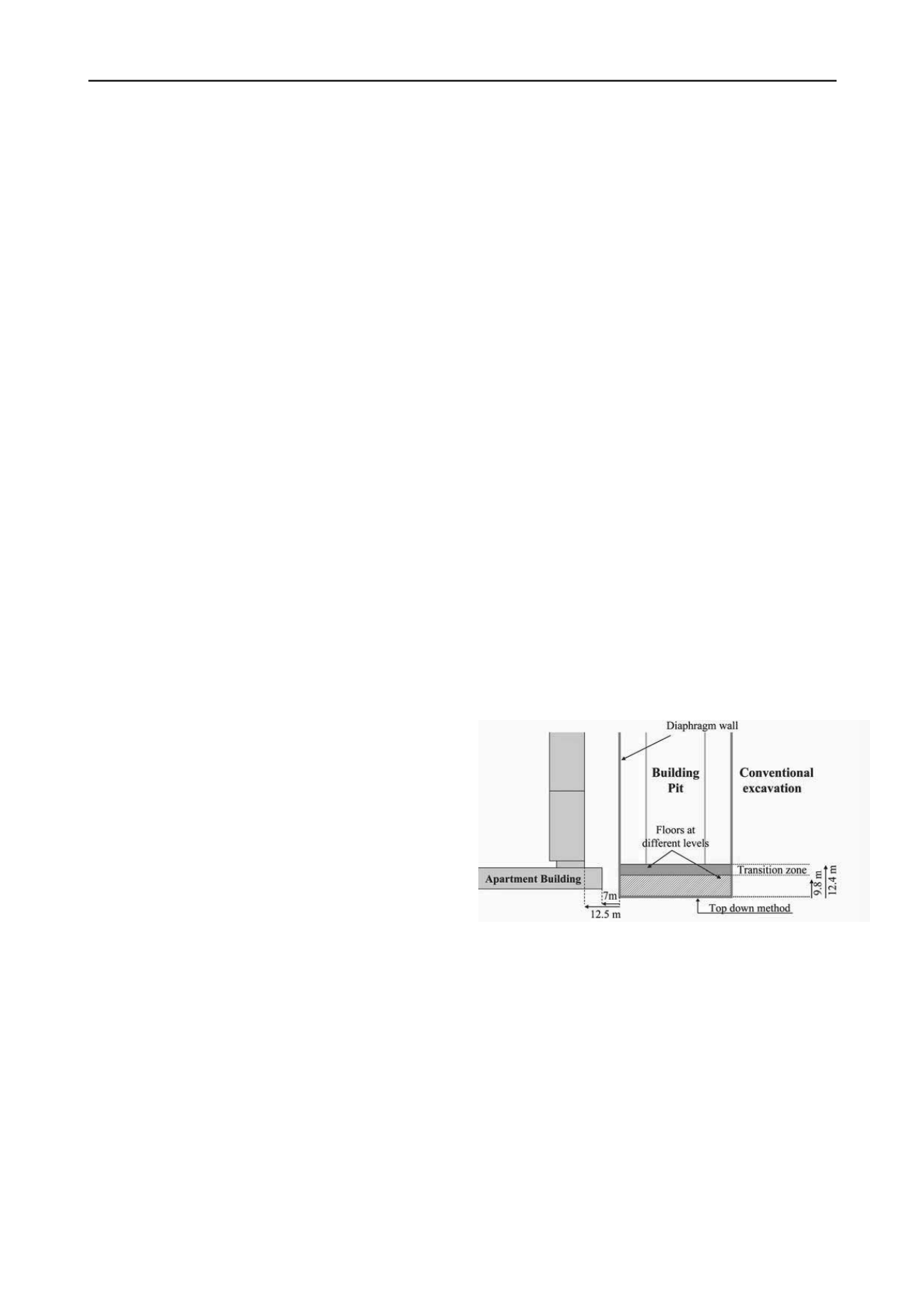
1916
Proceedings of the 18
th
International Conference on Soil Mechanics and Geotechnical Engineering, Paris 2013
deflections were in the order of 110 mm and maximum
settlements at the surface, around 80 mm.
R. Katzenbach and S. Leppla
describe results of ground
heave and settlement due to excavations, building construction
and de-construction. The measured behavior is time dependent
and occurs during years and the magnitude of the displacements
is in the order of several cm. The soil responsible for this time
dependent behavior is the overconsolidated Frankfurt clay. An
empirical formulation that approximately describes the time
dependent behavior is also proposed.
M. Korff and R. Mair
present building settlement results due
to deep excavations in Amsterdam. The difference between
ground surface and building response as a function of
foundation is highlighted and a methodology to evaluate
buildings response is presented. Surface settlements in the order
of 70 to 110 mm are presented, while the piled building settles
only in the order of 20 to 40 mm.
T. Mizutani and Y.Kikuchi
describe shaking table model tests
to test seismic behavior of caisson type quay walls. The aim of
the tests was to verify the possibility to increase water depth in
front of the quay after soil treatment – “solidification” in the
caisson foundation. It was found, that six different factors affect
the caissons improved by the “solidification”. Further research
will be performed to allow the development of a design
methodology.
T. Pucker and J. Grabe
present the structural optimization
method applied to geotechnical engineering design. This use is
new and, according to the authors, promising results were
obtained, showing potential economy and/or improvement in
performance.
V.Sesov et al.
present a methodology developed for the
evaluation of seismic response of historical monuments in
Macedonia. 3 Case histories are presented, where this
methodology was used.
A. Siemińska-Lewandowska et al.
describe different uses of
diaphragm walls: retaining structures and foundations. Vertical
load test results are presented, with up to 7,5 mm settlement for
150% of the working load. Interesting retaining structures using
T shaped diaphragm walls are also presented.
3 SELECTED TOPICS RELATED TO FOUNDATIONS
The papers presented related to foundations cover a wide range
of issues and foundation types:
Direct foundations:
Gravity “concrete” dam;
shallow footings (influence by diaphragm wall
construction;
influence
by
nearby
deep
excavations);
caissons – quay wall;
suction caissons;
Soil treatment for vertical loads by rigid inclusions;
Deep foundations:
Driven timber piles (influenced by nearby
excavation);
Precast concrete piles (influenced by nearby
excavation);
Barrettes and Diaphragm walls (as foundations and
retaining structures);
Seismic design and retrofitting of different foundations;
Long term settlement and heave in highly overconsolidated
clay;
Structural optimization technique – use of new technique to
optimize foundations.
Two topics were selected, among this wide range presented,
and are discussed in more detail.
Specifically seismic issues will not be discussed in detail in
this session, as a specific session at this same conference deals
with the theme.
3.1 Influence of Excavations on Foundations
The evaluations of
E. M. Comodromos et al.
showed that the
construction of diaphragm walls alone lead to settlement of
closely located direct foundations in the order of 5 mm. The
approach presented considered complex 3D nonlinear modeling,
where the excavated soil is replaced by bentonite slurry.
Aditionally to this theoretical aspect, it could be added that,
in the field, several times, especially in sandy soil below the
groundwater level or soft clays, the operation and movements of
the excavation equipment (clam shell, etc ) can generate
temporary negative suction pressures, leading to “cave-ins” and
additional settlements, that can be in the order of several cm.
M. Korff and R. Mair
and
G. Hannink and O. Oung
, present
monitoring results, as well as simulations of settlements induced
by deep excavations.
The results presented show significant difference between
measured settlements:
Korff and Mair
show settlements, in
Amsterdam, at the ground surface of more than 100 mm and, at
10 m from a 31 m deep excavation, building settlements of
almost 40 mm.
G. Hannink and O. Oung
, on the other hand,
present settlement measurements, in Rotterdam, of less than 10
mm for a building located 7 m from a 20 m deep excavation.
Both excavations are supported by braced diaphragm walls.
Possible explanations for these differences are probably:
Different soil profiles;
Different excavation depths;
Different diaphragm and bracing stiffnesses;
Appart from these rather obvious aspects, certainly:
Different pile length: in the case of the excavation in
Amsterdam, the piles are located well above the
excavation bottom, but in the case of Rotterdam, pile
toes are located almost at the same elevations;
Location of the buildings in relation to the excavation.
No specific information is available from Amsterdam,
but in Rotterdam, the building is located close to the
excavation, as can be seen in figure 2.
Figure 2. Position of building with relation to excavation (
G. Hannink
and O. Oung
)
This last topic can be confirmed by the analysis of the results
presented by
Horn-Da Lin et al
: the evaluations presented
show, qualitatively, that close to the excavation borders,
settlements are significantly lower than in the central part, as
can be seen in figure 3. The arrows show an approximate
possible position of the apartment building. It is clear that the
settlements are significantly lower than in the central part.
Depending of the geometrical conditions, it becomes clear
that 3D analyses may be necessary to adequately evaluate soil-
structure interaction.
With relation to settlements induced by excavation, in the
author´s opinion, the methodologies presented and discussed in
Korff and Mair
present tools to adequately predict building
response to deep excavations, in the case of deep foundations.


